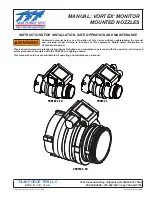
USER'S MANUAL
General instructions for use
I-Max Touch (110-120V)
(Rev. 0)
104
6.11
Research and correction of possible defects in
dental X-rays
6.11.1 Faults due to the wrong positioning of the patient
Problem
Description
Solution
Overlarge and blurred
incisors.
The patient is not positioned
correctly. He is too far from
the optimal focal plane.
Position the patient correctly, check
that he holds the bite with the
incisors on the appropriate notch
and that the bite holder rod is
vertical.
Over-small and
blurred incisors.
The patient is not positioned
correctly. He is too near the
optimal focal plane.
Position the patient correctly, check
that he holds the bite with the
incisors on the appropriate notch
and that the bite holder rod is
vertical.
Radiography with
blank central area.
The spine of the patient
inhibits the passage of the
X-ray as it is too
compressed.
Check the alignment of the
Frankfurt plane, try to stretch the
cervical part of the spine by moving
the patient's feet forward (see
paragraph 6.5.3 points 3/4/6/7)
and, if necessary, correct the height
of the chin support.
Asymmetric dental
arch.
The sagittal medial line does
not correspond to the laser
centring beam.
Realign the patient (see paragraph
6.5.3 point 6).
Upper apical area too
dark.
The patient does not keep
his lips shut and the tongue
is not against the palate.
See paragraph 6.5.3 point 8.
Upper central apical
area out of focus.
The patient keeps his head
rotated backwards
(Frankfurt plane not
aligned).
Position the patient again and
realign the Frankfurt plane.
The image is slanted in
comparison with the
longitudinal axis of the
image and some
anatomical structures
are not symmetric.
The patient's head is slanted
(not vertical).
Position the patient again, correcting
the position of the sagittal plane.
The teeth on one side
are bigger than those
on the other side.
The patient's head is rotated
with respect to the axis of
the bite.
Position the patient again, correcting
the position of the sagittal plane and
controlling that his head is not
rotated.
Presence (in CEPH
examination) of a
white area in the lower
part of the image.
Panoramic chin-rest still
mounted.
Perform the exam again, removing
the PAN chin-rest.
Содержание I-Max Touch
Страница 1: ...Version 25 September 2009 Rev 0 I Max Touch 0459 110 120V version User s Manual...
Страница 5: ...USER S MANUAL Contents I Max Touch 110 120V Rev 0 iv THIS PAGE IS INTENTIONALLY LEFT BLANK...
Страница 129: ...USER S MANUAL Maintenance I Max Touch 110 120V Rev 0 124 THIS PAGE IS INTENTIONALLY LEFT BLANK...
















































